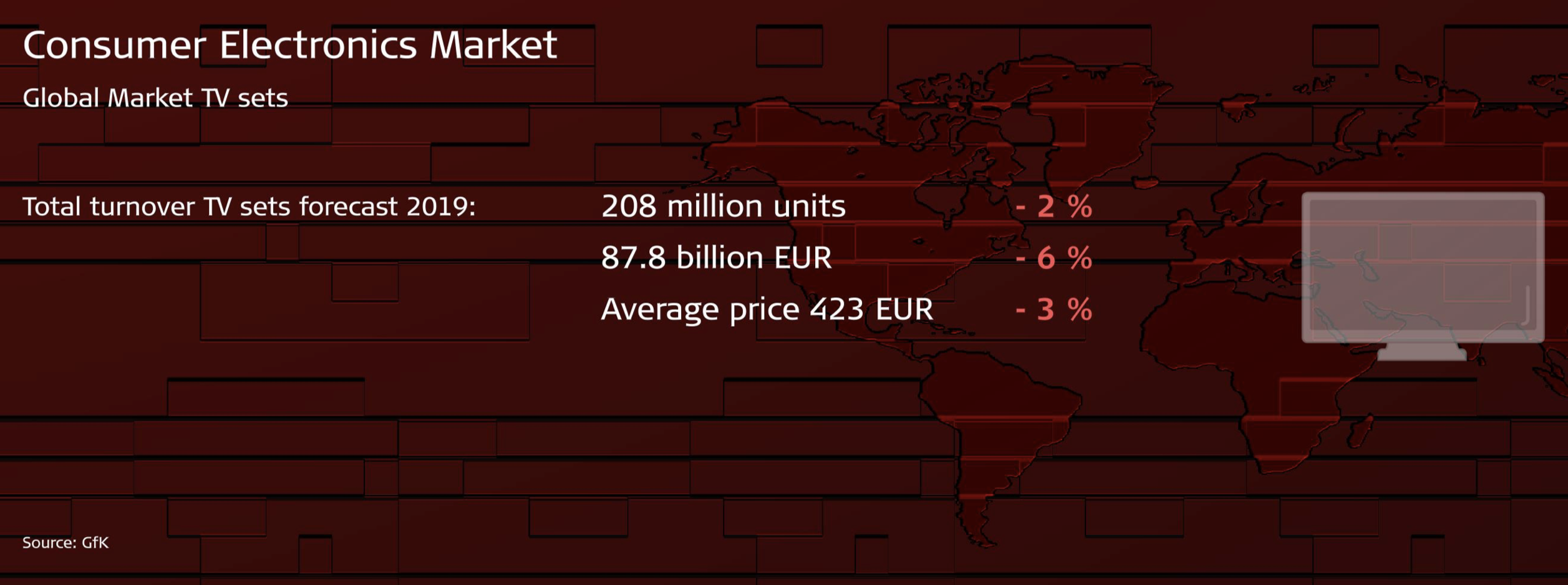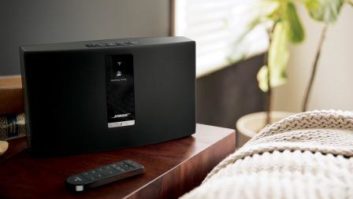
Political uncertainty, trade wars and regional economic worries are shaking consumer confidence, and TV prices continue a precipitous decline. These and other factors will combine to produce an overall slightly down year in overall consumer technology sales, according to market research company GfK. Depressing units sales and revenues in 2019 will be declining TV and smartphone purchases and average selling prices, while gaming gear, smart speakers and both major domestic and small appliances continue to be industry bright spots.
Overall industry sales of brown and white goods are projected to total of 1.011 trillion euro – or $1.12 trillion – this year, according to GfK, down a smidge from last year’s $1.013 trillion euro – $1.118 trillion – which represented a 3.6 percent growth over 2017. In 2017, industry sales revenues rose 7.4 percent over 2016.
Things seem to be down all over according to GfK. North America’s share of the worldwide consumer technology market also continues to drop, losing 2 percent over last year dipping to just 19 percent of global CT sales revenue. Only developing Asia sans China showed a regional global market share increase, rising 3 percent to 8 percent of the world market. China lost 3 percent of its global regional market share, but still represents the largest chunk of worldwide sales revenues at 27 percent.
“Overall, the market seems to be in a stable situation despite all critical factors like trade wars, Brexit or economic downturns in several countries,” explained Hans-Joachim Kamp, chair of the supervisory board of gfu Consumer & Home Electronics. “However it is impossible to foresee how these factors will influence the markets in the near future. In some countries we already see decreasing data in terms of the consumption climate and the willingness to buy.”
For the first time since their appearance a decade ago, sales of smartphones – still the dominant sector of the CT industry – are projected to fall below the previous year’s totals for the first time, both in units and dollars. According to GfK, global smartphones sales are projected to fall 1 percent to 1.407 billion units, and slip 2 percent in revenues to 445 billion euros, or $491 billion. Smartphone revenue slippage can be attributed not only to slightly fewer phones being sold but to a not-so-minor drop in the average selling price from 316 euro in 2018 to 315 this year.

The other major CT category, TV, also will suffer setbacks in 2019. Overall, units sales are forecast to fall 2 percent to 208 million units, and a whopping 6 percent loss in revenues, largely attributable to a 3 percent fall in the average selling price.
One opportunity to make up revenues may be consumer’s escalating interest in larger sets, according to GfK. In 2016, 50-to-59-inch TVs accounted for 29 percent of all TV sales; in 2019, however, these same sized sets will represent 35 percent of all TVs purchased. Similarly, 60-to-69-inch models now comprise 17 percent of TVs sold, compared to just 10 percent of the market three years ago.
“We sell TV sets with bigger screens and much better technology but the prices are going down and down,” observes Kamp. “Nevertheless our gfu survey has shown an untapped market potential for several years: an enormous gap between the average amount of money customers are willing to spend for a new TV set and the actual average price for all sold TV sets.”
The popularity of bigger screen TVs runs parallel with consumers snapping up 4K TVs – both traditional LCD LED models as well as OLED, especially in Europe where more OLED sets from a wider variety of suppliers are available. GfK says UHD TVs will total half of all TVs sold this year, a projected increase of 13 percent. Sales of OLED models will reach just 3.7 million units in 2019, but that represents an increase of 32 percent compared to 2018.
Despite increased uptake of bigger TVs, the average selling price for both LCD and OLED UHDs will plunge an eye-opening 11 percent this year.
“It’s a pity,” Kamp continues, “[that] the industry and the retailers are not able to get more money out of the customer’s wallet [for larger screen TVs], even though customers would be willing to spend more. We think stronger efforts of trade and industry to take advantage of this opportunity is more than desirable.”
Categories Rising
While sales of smartphones and TVs are disappointing, appliances, smart speakers and especially gaming gear are rising.
According to Futuresource, factory shipments of smart speakers will jump from 53.1 million units last year to 81.3 million this year, an impressive 53 percent YOY improvement, while GfK says sales of gaming gear will leap 14.3 percent in 2019. “Notebooks, monitors, keyboards, mice and headsets for gaming purposes are performing very well,” says Kamp, who cited the excitement around e-sports as a sales spark.
The increasing transformation of appliances into smart AI-driven digital devices is prompting increased sales. A slight 2 percent rise in unit sales of major domestic appliances (MDA) is forecast by GfK, and sales of small appliances, buoyed by personal care, coffee makers and wellness devices, will experience a healthy rise of 9 percent in 2019.
See also: New LG Factory In China Could Make OLED TVs More Affordable













